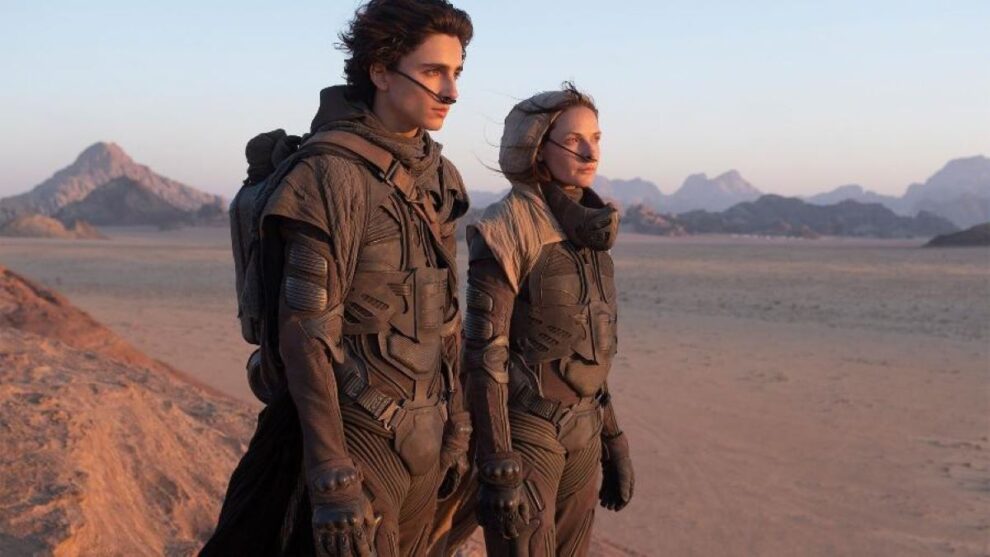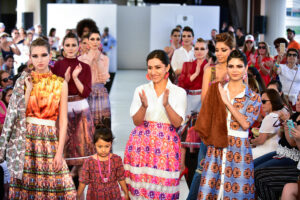Moviegoers have been waiting a long time for the latest reimagining of Dune to hit the silver screens. Originally set to release in November 2020, the premiere has been pushed back at least three times, and finally makes it to theaters and streaming on HBOMax October 22. But production designer Patrice Vermette has been waiting years for the movie—starring Timothée Chalamet, Oscar Isaac, Zendaya, Javier Bardem, and more—to come to fruition, considering he started traveling to scout for filming locations for Dune in 2018.
The film, which takes place primarily on a desert planet called Arrakis, was shot in four locations: Wadi Rum in Jordan, the desert outside of Abu Dhabi, the northwest coast of Norway, and the soundstages of Origo Studio in Budapest. “Without those four places, there is no Dune,” Vermette says.
To learn how the crew mashed up two deserts to create the planet Arrakis, staying at an Anantara resort outside Abu Dhabi, and which sets you can actually visit, we sat down with Vermette himself to chat all things Dune.
What went into picking the perfect desert—or deserts—to serve as Arrakis?
We needed to find a desert that wouldn’t be romantic or beautiful or like a postcard. It needed to be a place that was scary—the kind of desert where if you’re stranded there, it’s death for sure. We needed it to have a violence to it.
We started the process by traveling through Google, looking at the different deserts of the world. We looked at amazing deserts in Chile, in Iran, in Chad, in Yemen, in Libya. But I’m naming countries that are very difficult to access for film production. But [the director] Denis [Villeneuve] had shot a film called Incendies in Jordan and remembered going to Wadi Rum. We’re reading the script, and we realized, yes, there’s dunes—but there are also a lot of rock formations. And we found that the location that gave us the most amazing choices in rock formation was the deserts of Wadi Rum and Wadi Araba in Jordan. There’s just a presence there, an aura. You feel very, very, very small in the universe when you’re there, and just the sound of the wind between those rocks is just breathtaking.
But even if Jordan worked out for the storytelling, we also needed a place that had intense sand dunes. We were trying to find a place that had 360 degrees of dunes. So in the sand dune world, we had selected Abu Dhabi, Dubai, and Morocco—those were the ones that we wanted to see for ourselves. And as soon as we scouted the desert in Abu Dhabi, we were like, this is the place.
Where we were was about a three-hour drive from the [Abu Dhabi] airport and we stayed in a resort in the middle of the desert called Qasr Al Sarab. Traveling from the hotel to the filming location was like going right outside the resort’s door. It was fantastic.
The main city on Arrakis was built with CGI, but were there any real life destinations that inspired how it looked?
Absolutely not. For Arrakis, I had a mix of references that I used: World War Two bunkers, Ziggurat architecture, Mayan architecture. It was all influenced by the condition and elements of Arrakis, like the wind that goes at 850 kilometers an hour, as mentioned in the book, and the reality of sandworms. So the city came out of our imagination. There’s no real there’s no place like that.
Both visually and in the storyline, the planet Caladan is the complete opposite of Arrakis. What locations did you use to kind of create that difference?
Norway. Very early, I said that Norway—the northern part of Norway, not the fjords, but the seaside—would be interesting to explore. We had great location scouts in Norway based in Alesund and we ended up shooting in the area of Kråkenes. When I first scouted the region, it was during a week in the year with the least amount of sunlight—like the week of December 21. There were only like four hours of sunlight a day and the sun was always very, very low. It was such dramatic light on those islands and the cliff sides—it was just spectacular. But we ended up shooting close to the longest daylight period of the year, in August 2019. The light conditions were totally different, so different that it was too sunny for the aerial photography and we had to go back and do all the aerial shots that October.
Did you have a favorite location to film—even among any of the interiors your team built out on sound tages?
Wadi Rum and Wadi Araba, I think, spiritually, there’s a power to that place that is just unbelievable. And Norway, because it was just this majestic landscape. I’d like to go back when I’m not working nice, like really travel—especially Norway during the winter. Building-wise, I’m super proud of the architecture on Caladan. We had so much fun. It has this medieval/Japanese influence in the design.
One specific filming location that I just have to get the details on is the drum of a desert room on Arrakis where Paul, played by Timothée Chalamet, Duncan, played by Jason Momoa, and Jessica, played by Rebecca Ferguson escape. Where did you find such an enormous space?
That was straight out of my head. I remember an early meeting with the producers and they were like, Okay, these are really nice drawings that you and your team of concept artists have come up with, but how the hell are we going to do it? It was extremely challenging because of the sheer size of it. The brief from Denis was to give him and the actors as much of an immersive environment as possible—so we weren’t allowed to use green screen. So we actually used this huge open space in between the sound stages at Origo Studio [in Budapest], and we built up to 20 feet of real set elements—like part of the circular room—and then had fabric to create the space. We created the shadows over the space by rigging lines between the stages out of metal wire. And we just covered the ground completely with sand—and had to keep covering it up because it was the rainy season in Budapest. I know at one point that there were people who wanted to shoot me for coming up with this idea because it was so much work, but I really owe a lot to Gergely Rieger, one of the art directors, and Paul Lambert, for the visual effects, for [making it happen.]
Source: Conde Nast Traveler































